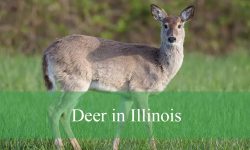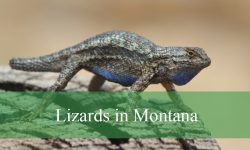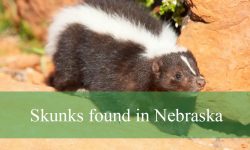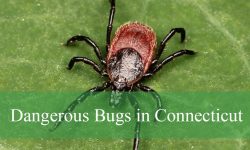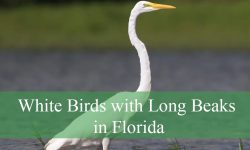Owls hold a special place in Utah’s diverse landscapes, from desert valleys to alpine forests. These nocturnal hunters are not only fascinating for their silent flight and piercing eyes but also for their important role in maintaining ecological balance. Spotting one in the wild is a memorable experience for birdwatchers and nature enthusiasts alike.
Utah provides habitat for a wide variety of owl species, ranging from the tiny Northern Saw-whet Owl to the imposing Great Horned Owl. Some are permanent residents, while others migrate or appear only in rare seasons. Each species has its own unique adaptations, behaviors, and preferred environments, making the study of owls both complex and rewarding.
In this guide, we’ll explore 13 different types of owls that can be found in Utah. You’ll learn how to identify them, understand their sizes and behaviors, and discover where they are most likely to be spotted. Whether you are an avid birder or simply curious, this article will help you appreciate these mysterious raptors more deeply.
Different Types of Owls Found in Utah
Great Horned Owl (Bubo virginianus)
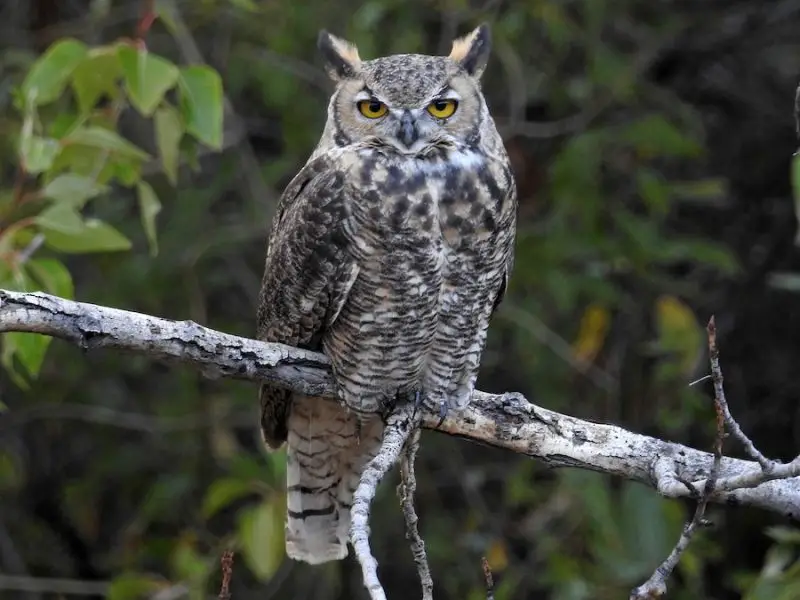
The Great Horned Owl is one of the most powerful and widespread owls in Utah. It has a stocky body with broad wings, large yellow eyes, and distinctive feather tufts on its head that resemble horns. Its plumage is a mottled mix of brown, gray, and white, which provides excellent camouflage against tree bark and rocky landscapes. This owl is highly adaptable, found in forests, deserts, canyons, and even urban areas.
In terms of size, the Great Horned Owl is among the largest owls in North America. It measures about 18–25 inches in length, with a wingspan ranging from 40–57 inches. Adults usually weigh between 2–5.5 pounds, with females being larger than males. Its powerful talons can exert tremendous pressure, making it a formidable predator.
Behaviorally, this owl is a nocturnal hunter, relying on its sharp vision and exceptional hearing to catch prey in complete darkness. It feeds on a wide range of animals, including rabbits, rodents, skunks, snakes, and even other birds. Its deep, resonant hoot is one of the most recognizable sounds of the night in Utah.
Great Horned Owls nest in abandoned nests of hawks, crows, or squirrels, as well as cliffs or tree cavities. They are year-round residents in Utah and are especially active during late winter when their breeding season begins.
Barn Owl (Tyto alba)
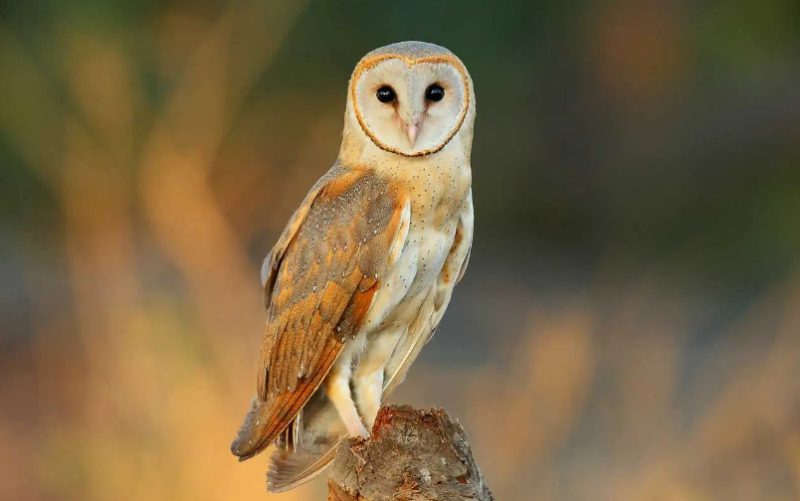
The Barn Owl is a striking species with a heart-shaped facial disc, dark eyes, and pale plumage. Its upperparts are golden-brown speckled with gray, while its underparts are white to light buff. It is often seen flying low over fields and grasslands at night, searching for prey. In Utah, Barn Owls thrive in open landscapes, agricultural lands, and areas with old barns or abandoned buildings.
This owl is medium-sized, measuring 12–16 inches long with a wingspan of 39–49 inches. Its weight ranges from 0.9–1.4 pounds, making it lighter than most other owls of similar size. Its long wings and buoyant flight allow it to glide silently in search of small mammals.
Barn Owls are known for their eerie, raspy screech rather than the traditional hooting sound associated with owls. Their diet primarily consists of mice, voles, and rats, which they hunt using exceptional hearing aided by their asymmetrical ears. A single Barn Owl can eat thousands of rodents in a year, making them highly beneficial to farmers.
They typically nest in tree cavities, cliffs, and man-made structures. In Utah, Barn Owls are permanent residents, especially in areas with open farmland. Their ghostly white figure gliding at night often earns them a mysterious reputation.
Western Screech-Owl (Megascops kennicottii)
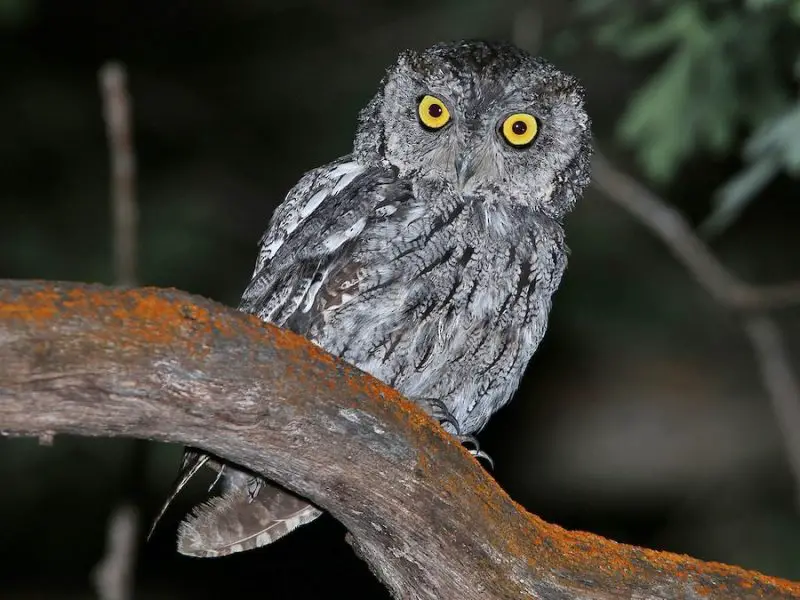
The Western Screech-Owl is a small but charismatic owl found in Utah’s woodlands, deserts, and suburban neighborhoods. It has a compact body, yellow eyes, and small ear tufts. Its plumage ranges from gray to brown, mottled with streaks that blend well with tree bark, making it nearly invisible during the day.
This species measures about 7–10 inches in length, with a wingspan of 18–24 inches. Adults weigh between 3.5–11 ounces. Despite its small size, it is a skilled hunter capable of taking down prey almost as large as itself.
Western Screech-Owls are primarily nocturnal, emerging at dusk to hunt insects, small mammals, birds, and even fish. Their call is not a true “screech” but a series of soft, bouncing hoots. They are cavity nesters, often using tree holes, old woodpecker nests, or even nest boxes.
In Utah, they are year-round residents and can adapt well to human presence. Many birdwatchers encounter them in rural backyards where old trees or nest boxes are available.
Flammulated Owl (Psiloscops flammeolus)

The Flammulated Owl is a tiny, secretive species found in Utah’s high-elevation pine and fir forests. Its name comes from the flame-like reddish markings on its feathers. It has a gray-brown body with subtle streaks, short ear tufts, and dark eyes, blending well into bark and shadows.
This small owl measures just 6–7 inches in length with a wingspan of 15–16 inches. It weighs only about 1.5–2 ounces, making it one of the lightest owls in North America. Despite its small size, it has a surprisingly deep hooting call.
Flammulated Owls feed primarily on insects such as moths, beetles, and crickets, which they catch during nighttime flights. They migrate seasonally, arriving in Utah during late spring and leaving for Central America in the fall.
These owls prefer old-growth forests with tall trees for nesting. They often use abandoned woodpecker holes for raising their young. Because of their small size and secretive nature, they are challenging to spot in Utah, but their soft hoots at night are a clue to their presence.
Northern Saw-whet Owl (Aegolius acadicus)
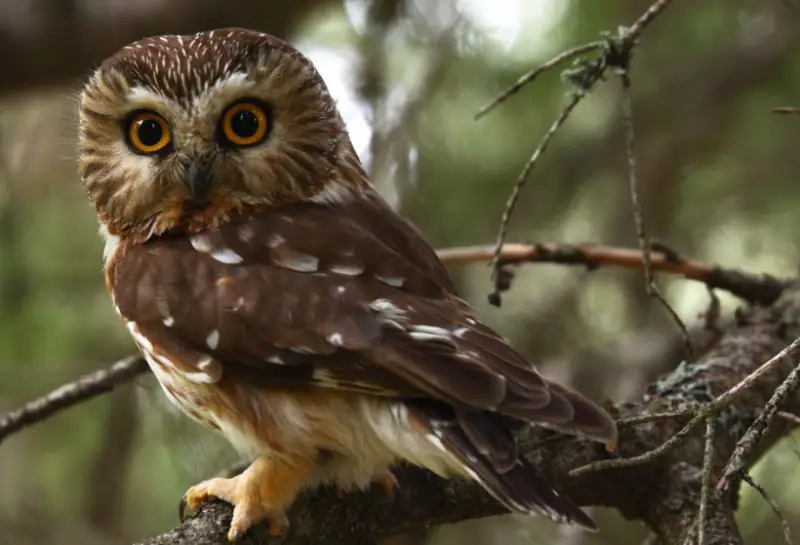
The Northern Saw-whet Owl is a small but endearing owl with a round head, no ear tufts, and striking yellow eyes. Its plumage is brown with white streaking on the head and vertical streaks on the underparts. This gives it a wide-eyed, curious expression that makes it a favorite among bird enthusiasts.
In terms of size, this owl is quite small, measuring 7–9 inches long with a wingspan of 16–22 inches. Adults weigh only about 2–5 ounces, making them comparable to a robin in size. Despite their small stature, they are effective predators.
Northern Saw-whet Owls feed mostly on small mammals such as mice, voles, and shrews. They are nocturnal and often go unnoticed due to their quiet, secretive behavior. Their call is a repetitive, high-pitched “too-too-too” that can continue for minutes at a time.
They inhabit coniferous and mixed forests across Utah, often nesting in old woodpecker holes. Although elusive, they can be found more easily during migration periods when they move through different habitats.
Long-eared Owl (Asio otus)
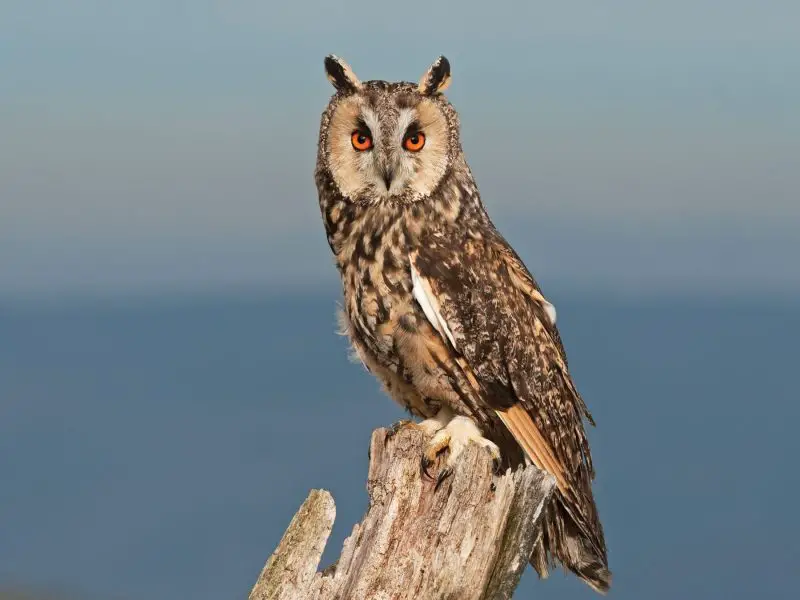
The Long-eared Owl is a medium-sized owl recognized by its slender body, long ear tufts, and striking orange eyes. Its plumage is a mottled mix of brown, buff, and black, helping it blend into tree branches. When roosting during the day, it often presses its body upright and stretches tall, mimicking a broken branch to stay camouflaged.
This species measures about 13–16 inches in length, with a wingspan ranging from 34–40 inches. Adult Long-eared Owls typically weigh between 7–15 ounces. Their long wings and lightweight build allow them to fly silently through dense vegetation when hunting.
Long-eared Owls are nocturnal hunters, feeding primarily on small mammals such as voles, mice, and shrews. They sometimes eat small birds, particularly during winter. Their call is a series of deep, single hoots, usually spaced several seconds apart, and can be heard from a great distance.
In Utah, they favor dense woodlands or tree groves for roosting, usually near open fields where they can hunt. They are year-round residents but may move southward in harsh winters. Roosting sites are often communal, with several owls gathering together in winter.
Short-eared Owl (Asio flammeus)

The Short-eared Owl is one of the few owl species commonly seen during the day, especially at dawn and dusk. Unlike its close relative the Long-eared Owl, its ear tufts are almost invisible, giving it a round-headed appearance. Its plumage is buffy brown with streaks and spots, blending perfectly with grasslands and marshes.
It measures 13–17 inches in length, with a wingspan of 33–43 inches. Adults typically weigh 7–17 ounces. Compared to other owls, it has long wings that give it a buoyant, moth-like flight as it glides low over open fields.
This owl primarily hunts voles, mice, and other small rodents. Its hunting style is distinctive, as it flies slowly over grasslands with frequent hovering and sudden dives. Short-eared Owls are semi-nomadic, moving to areas where rodent populations are high.
In Utah, they are often spotted in open habitats such as marshes, prairies, and agricultural fields. They may be seen year-round in some regions, though many migrate southward in winter. Their presence is strongly tied to the availability of prey.
Burrowing Owl (Athene cunicularia)
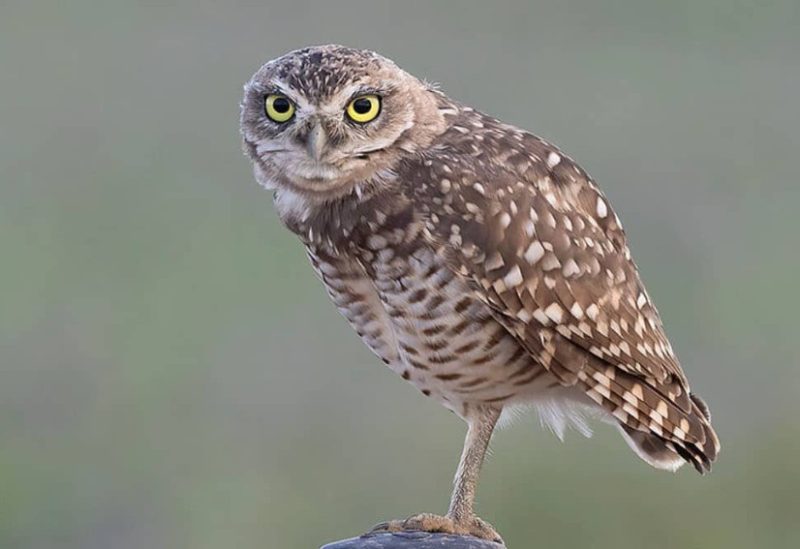
The Burrowing Owl is a unique ground-dwelling owl often found in Utah’s open landscapes such as deserts, grasslands, and farmlands. Unlike most owls, it is frequently active during the day, especially in the early morning and late afternoon. It has long legs, bright yellow eyes, and a short tail, with brown plumage covered in white spots.
This species measures 7–10 inches in length, with a wingspan of 20–24 inches. Adults weigh between 5–8 ounces. Its long legs give it an unusual upright posture compared to other owls.
Burrowing Owls are opportunistic feeders, preying on insects, small mammals, reptiles, and amphibians. They are also known to store food in their burrows to prepare for scarce periods. Their call is a series of chattering or cooing sounds, unlike the hoots of many other owls.
In Utah, Burrowing Owls use abandoned prairie dog or ground squirrel burrows for nesting and roosting. They are more commonly seen in summer months when breeding, though some may remain year-round in southern parts of the state.
Northern Pygmy Owl (Glaucidium californicum)

The Northern Pygmy Owl is a small but fierce predator found in Utah’s forests and foothills. Despite its small size, it has a bold personality and often hunts during the day. It has a round head without ear tufts, yellow eyes, and a short tail. One unique feature is the presence of two dark “false eyes” on the back of its head, which confuse predators.
This owl measures only 6–7 inches in length, with a wingspan of 12–16 inches. Adults weigh just 2–2.5 ounces, making it one of the smallest owls in Utah.
Northern Pygmy Owls hunt small birds, rodents, and insects. They are agile and capable of catching prey larger than themselves. Their call is a series of high-pitched, tooting whistles, often repeated for several minutes.
In Utah, they prefer mixed coniferous and deciduous forests. They use old woodpecker holes for nesting and are most easily spotted in the daytime when perched on exposed branches, scanning for prey.
Spotted Owl (Strix occidentalis)
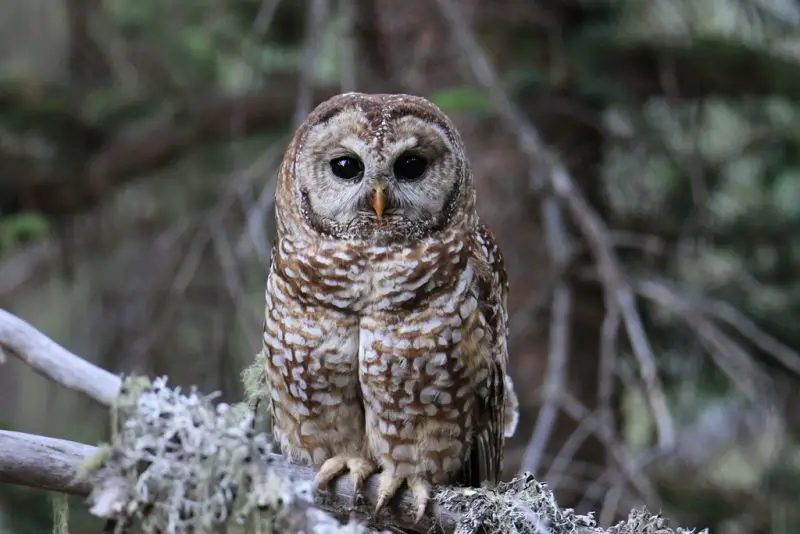
The Spotted Owl is a rare and sensitive species in Utah, typically inhabiting old-growth forests and canyonlands. It has dark brown plumage covered with distinctive white spots, large dark eyes, and a rounded head without ear tufts. Its appearance gives it a gentle, almost solemn look.
This owl is medium to large, measuring 16–19 inches long with a wingspan of 39–49 inches. Adults weigh between 1–1.5 pounds. Its broad wings allow it to fly quietly through dense forests in search of prey.
Spotted Owls primarily feed on small mammals such as woodrats and flying squirrels but also consume birds, insects, and reptiles. They are nocturnal hunters, using perches to scan the forest floor before gliding down silently to capture prey. Their call is a series of deep hoots, often used in territorial communication.
In Utah, Spotted Owls are rare and primarily found in forested mountain regions and canyon habitats. Due to habitat loss and competition from the invasive Barred Owl, their populations are declining, making them a species of conservation concern.
Barred Owl (Strix varia)
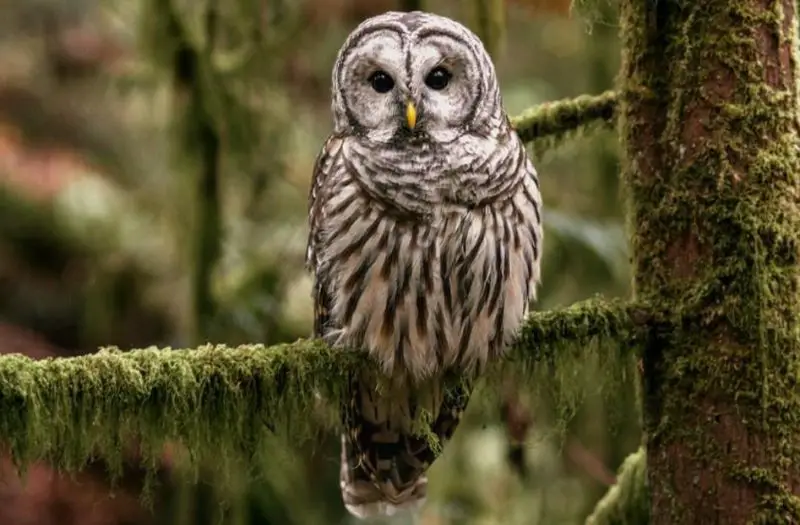
The Barred Owl is a large, striking species known for its soulful dark eyes and rounded head without ear tufts. Its plumage is patterned with horizontal barring across the chest and vertical streaks on the belly, giving it its name. The bird’s hooting call, often described as sounding like “Who cooks for you? Who cooks for you all?” is one of the most iconic owl sounds.
This owl measures 16–25 inches in length, with a wingspan of 38–49 inches. Adults usually weigh between 1–2.5 pounds, making it slightly smaller than the Great Horned Owl but still quite large compared to most other species. Its broad wings and silent flight make it an efficient nocturnal hunter.
Barred Owls primarily eat small mammals, birds, amphibians, reptiles, and occasionally fish or invertebrates. They are opportunistic predators, capable of adapting their diet depending on habitat. Unlike some other owls, they are not strictly nocturnal and can sometimes be active during the day, especially around dawn and dusk.
In Utah, Barred Owls are relatively uncommon but are slowly expanding their range into the state. They are most often found in wooded river corridors, canyons, and dense forests. Their spread into western states has raised concerns about competition with the more vulnerable Spotted Owl.
Snowy Owl (Bubo scandiacus)

The Snowy Owl is one of the most magnificent owls, instantly recognizable by its large size and brilliant white plumage, often speckled with dark markings. Males are usually whiter than females, while younger birds have heavier barring. Their piercing yellow eyes stand out against their pale feathers, creating a dramatic look.
This species is among the largest owls, measuring 20–28 inches in length with a wingspan of 49–57 inches. Adults weigh between 3.5–6.5 pounds, with females being larger than males. Their heavy build and thick feathering make them well adapted to frigid environments.
Snowy Owls primarily hunt lemmings and other small mammals but will also take birds such as ducks and geese when available. Unlike most owls, they are diurnal hunters, often active in the daytime, especially in their Arctic breeding grounds. Their hunting style involves perching on open ground or fence posts, then swooping down quickly on prey.
In Utah, Snowy Owls are rare winter visitors, usually appearing during “irruption years” when food shortages drive them south from the Arctic. They are most often seen in open landscapes such as fields, marshes, and airport runways, where they mimic the tundra environment they prefer.
Boreal Owl (Aegolius funereus)
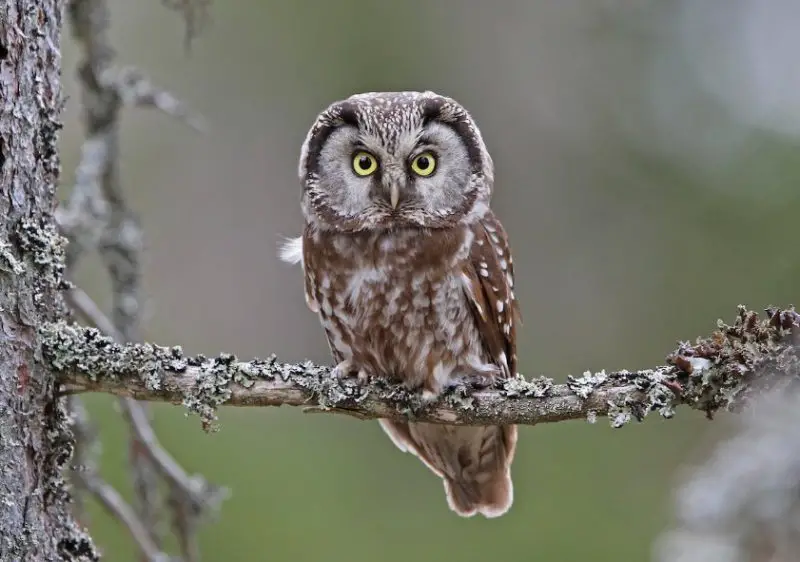
The Boreal Owl is a secretive, small owl that inhabits Utah’s high-elevation coniferous forests. It has a rounded head, large yellow eyes, and no ear tufts. Its plumage is brown with white spots on the crown and back, while the underparts are pale with streaking. Its expression often looks wide-eyed and curious.
This owl measures 8–11 inches in length, with a wingspan of 20–24 inches. Adults weigh between 3–7 ounces, making it a small but sturdy forest-dwelling owl. Despite its size, it is an efficient nocturnal predator.
Boreal Owls mainly hunt small mammals, especially voles, but they may also eat birds and insects. Their call is a series of clear, high-pitched hoots that carry through quiet mountain forests at night. They are elusive, and birdwatchers often detect them by sound rather than sight.
In Utah, Boreal Owls are uncommon and restricted to dense mountain forests, particularly in northern and central regions. They nest in old woodpecker cavities and remain difficult to observe due to their secretive nature. Their presence is more often confirmed during late winter and early spring when males call to attract mates.
Best Time and Places to See Owls in Utah
Owls in Utah can be seen year-round, but the best time to observe them is during the breeding season, which usually occurs from late winter through spring. Great Horned Owls begin nesting as early as January, making this an excellent time to hear their territorial hoots echoing across forests and canyons. Summer evenings are also rewarding for spotting species like the Flammulated Owl and Burrowing Owl, which are more active during warmer months. Winter provides rare opportunities to see Snowy Owls in open landscapes during irruption years.
The best places to see owls in Utah vary by species and habitat. Mountain forests, such as those in the Wasatch Range and Uinta Mountains, are prime spots for Boreal Owls, Northern Saw-whet Owls, and Northern Pygmy Owls. Grasslands and agricultural areas across the Great Basin are excellent for finding Short-eared and Burrowing Owls. Wetlands, canyons, and river corridors also host species like Barred and Long-eared Owls. Birdwatchers exploring diverse environments have the best chances of encountering multiple species.
Nighttime is generally the most productive period for owl observation, as most species are nocturnal hunters. However, a few, such as the Burrowing Owl and Northern Pygmy Owl, are active during the day, giving birders opportunities to spot them without night vision aids. Using your ears is just as important as your eyes, since many owls reveal their presence through distinctive calls long before they are seen.
FAQs about Owls in Utah
What is the most common owl in Utah?
The Great Horned Owl is the most widespread and common owl in Utah. It can be found in deserts, forests, canyons, and even urban areas throughout the state.
Are Snowy Owls found in Utah?
Yes, Snowy Owls occasionally appear in Utah during winter, especially in irruption years when food shortages push them south from the Arctic. They are rare but can be seen in open fields and marshlands.
Where can I see Burrowing Owls in Utah?
Burrowing Owls are often seen in grasslands, deserts, and agricultural fields. They nest in abandoned prairie dog or ground squirrel burrows, making them more visible than most owls during daylight hours.
Do owls live in Utah year-round?
Most owl species, including Great Horned, Barn, and Western Screech-Owls, live in Utah year-round. However, some species like the Flammulated Owl and Snowy Owl are seasonal visitors.
Are owls protected in Utah?
Yes, all owls in Utah are protected under the Migratory Bird Treaty Act. It is illegal to harm, harass, or capture them, and disturbing nests is strictly prohibited.
Can I attract owls to my backyard in Utah?
Yes, owls can be encouraged by providing nest boxes, especially for species like Western Screech-Owls and Barn Owls. Reducing pesticide use and maintaining natural habitats also helps attract them.

